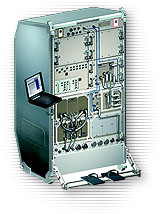European drawer rack
The European Drawer Rack ( EDR ) is a European payload in the form of an International Standard Payload Rack , which was developed by Alenia Spazio on behalf of the European Space Agency (ESA) for the Columbus space laboratory . Parts were also built by ASTRIUM GmbH and OHB-System AG in Bremen . The EDR is a multi-user system for accommodating various experiments, which can simply be pushed into the drawer rack. It provides them with practically all of the interfaces and supply lines they need. It is thus possible to carry out small and medium-sized experiments on the ISS with relatively little effort.
EDR supports both the European and the American standard installation size for experiment racks (Experiment Container Modules (ECM)). Up to three experiments in the "ISIS drawer format" and four in the form of an "ISS locker" (see ISPR ) can be recorded. The following interfaces are available:
- Power supply (28 V DC, 120 V DC)
- Low rate telecommands / telemetry (19.2 kbit / s RS-422 )
- Medium rate telecommands / telemetry (10 Mbit / s Ethernet )
- High rate telemetry (32 Mbit / s SpaceWire )
- Analog video inputs ( NTSC )
- Discreet command, surveillance and temperature monitoring service
- Air cooling
- Water cooling
- Nitrogen gas connection
- Vacuum service
- Consumption gas service
- Timeline service
- Help data and time service
- Laptop crew interface
The following ESA payloads used the EDR:
- Protein Crystallization and Diagnostics Facility (PCDF)
- Erasmus Recording Binocular (ERB-2)
- KUBIK Interface Drawer (KID-KUBIK)
- Facility for absorption and surface tension studies on the European drawer rack (FASTER)
- ElectroMagnetic Levitator (EML)
The FRC ( Facility Responsible Center ) for EDR is the Erasmus USOC at the European Space Research and Technology Center in Noordwijk , the Netherlands .
See also
Web links
- ESA: European Drawer Rack (English)
- Erasmus User Support and Operations Center ( Memento from September 3, 2013 in the web archive archive.today ) (English)
- ESA bulletin chapter on EDR ( PDF file in English; 140 KB)
